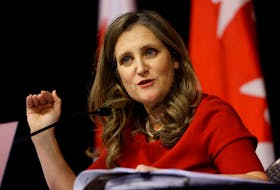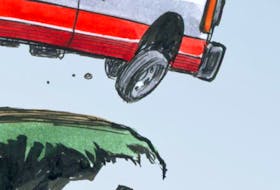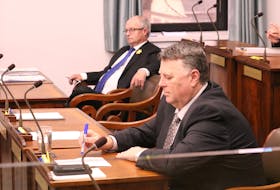Ontario Premier Doug Ford called the projected spread of COVID-19 in the country’s largest province “stark and sobering”.
Ontario is the first jurisdiction in Canada to share the modelling on which public policy decisions are being made, including projected fatalities.
No wonder the premier, and health minister, Christine Elliott, looked ashen-faced. The province is expecting a surge in the number of cases of the virus this month – as many as 80,000, up from the current 3,255, leading to 1,600 deaths in April alone, an increase from the 67 current fatalities.
The numbers released Friday suggest it is possible, if not likely, that Ontario will have fewer than half the number of intensive care beds that will be required this month, even after it adds new capacity.
The current hospitalization rate is around 14 per cent, of which nearly half require intensive care treatment. If the 80,000 cases projection is accurate, the province is going to need more than 4,000 ICU beds. Yet Ontario currently has just 410 ICU beds, with plans to bring another 900 into service in field hospitals, hotels and long-term care homes.

Things are about to get incredibly ugly and sad.
The province offered a best-case scenario where deaths are limited to 200 this month and the number of intensive care patients does not breach the additional capacity.
Elliott said all hospitals have a plan in place to ramp up their ICU bed space – which is just as well, since the modelling suggests that even in the best case scenario, all existing ICU beds will be filled as soon as this Sunday.
Under the more rosy projection, the number of acute care patients starts to decrease around mid-month. Ford said the province is taking additional measures to try to reach that point, closing all construction sites from Saturday, with the exception of those building medical infrastructure.
Ford practically begged Ontarians to stay home. “The ending of our story is up to us,” he said.
The only consolation is that things could have been much, much worse. Without the school closures and enforced social distancing imposed by the province, the modelling suggested there would have been 300,000 cases in Ontario this month, and 6,000 deaths.
The ending of our story is up to us
“[The modelling] reveals a disastrous path now avoided but it is also a call for greater action,” said Elliott.
“Everything we’ve done so far is working,” said Ford.
The mortality rate from COVID in the province is around two per cent but that figure rises to 10 per cent for the over 70s and 16 per cent for those over 80.
Peter Donnelly, the president of Public Health Ontario, said the full course of the pandemic may last 18 months to two years, with smaller secondary and tertiary waves.
The death toll in that period would range between 3,000-15,000, he said.
If 1,600 people die in April alone, it would appear the province is on course to hit the higher end of that estimate.
Donnelly said he appreciated that many people will view the projected death rate as “scary and intimidating” but the context is that 1,500 people die of seasonal flu in the province in a bad year. COVID-19 has a mortality rate that is 10 times higher, there is no vaccine and no specific treatment, which makes 15,000 deaths a realistic estimate, he said. “Where we end up depends on all of us.” Donnelly warned that a relaxation of social distancing measures is “some way off”.
Ford was subdued, clearly troubled by the implications of the news he was passing on. “We could see 80,000 afflicted by this terrible virus this month. That’s 1,600 people dead, 50 a day, two every hour. Each one could be your brother, sister, mother, father, grandparent or friend,” he said.
No-one could accuse him of sugar-coating the pill – and nor should he have.
It was only when he was asked about the move by the Trump Administration to invoke the Defence Production Act to prevent manufacturer 3M from selling respirators to Canada that he recovered his customary bounce.
“I can’t say how disappointed I am with President Trump. I understand he wants to look after his own people but we are connected,” he said.
Ford said he had discussed supply issues with Prime Minister Justin Trudeau and other provincial premiers.
“Never again it the history of Canada should we be beholden to another country for the safety and well-being of the people of Canada,” he said.
At the end of this long, dark tunnel, it sounds like supply of food, medicine and medical equipment will be managed by provincial and federal governments to guarantee inventory.
Meantime, Ontarians can prepare themselves for the grim month ahead, armed with the bad news. At least this way, the only surprise will be if they manage to defy expectations.
• Email: [email protected] | Twitter: IvisonJ
Copyright Postmedia Network Inc., 2020








